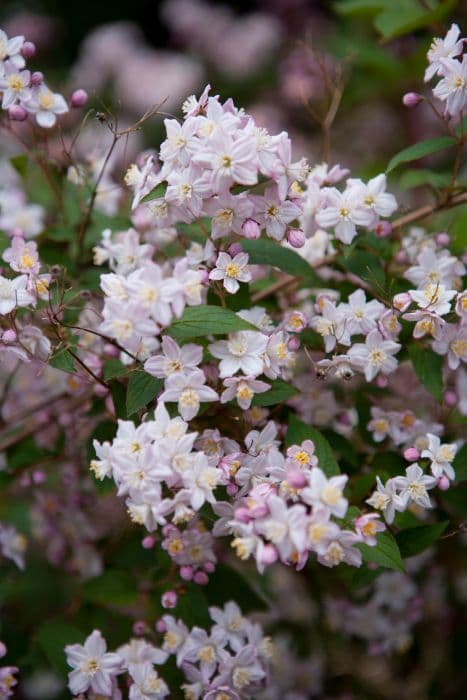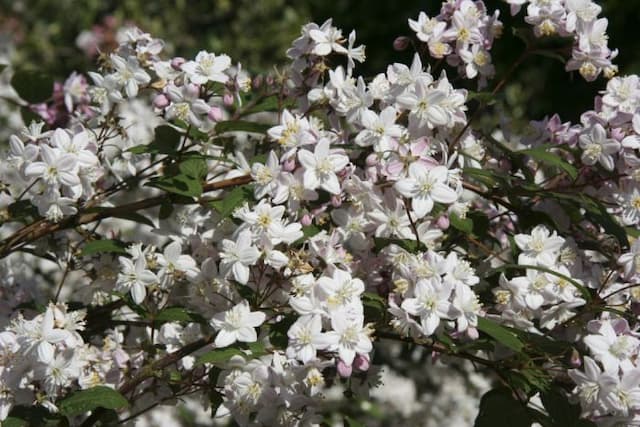Mophead Hydrangea Hydrangea macrophylla 'Ayesha' (H)

ABOUT
Hydrangea macrophylla 'Ayesha' is a beautiful ornamental plant with a distinctive appearance. It is recognized for its lush foliage and stunning, large flower heads. The leaves are deep green, glossy, and have a somewhat ovoid shape, contributing to a dense, bushy look. This hydrangea's most striking feature is its blooms, which are not the typical mophead or lacecap flowers associated with other hydrangeas. The flower heads of 'Ayesha' are composed of small, cupped individual florets that resemble miniature lilac blossoms. The florets are tightly packed together, creating a full, rounded appearance for each cluster. They can take on various colors, ranging from blue, pink, or purple, to even a delicate mauve, depending on the soil pH. Occasionally, the blooms may exhibit a mix of these hues, providing a beautiful multi-colored display. Each individual floret is subtly crinkled with a slightly shiny texture, which catches light and adds a unique shimmer to the plant. The enchanting flowers exude a gentle, sweet fragrance, which makes 'Ayesha' hydrangea not only a visual treat but also a delight for the other senses. The combination of the textured blooms and the robust foliage makes Hydrangea macrophylla 'Ayesha' a lovely addition to any garden. It provides a romantic, vintage feel and serves as an excellent focal point for ornamental landscaping. This hydrangea can also be used in floral arrangements, where its charming florets steal the show with their delicate and unusual beauty.
About this plant
 Names
NamesFamily
Hydrangeaceae
Synonyms
Mophead Hydrangea, Bigleaf Hydrangea, French Hydrangea, Lacecap Hydrangea, Hortensia
Common names
Hydrangea macrophylla 'Ayesha'
 Toxicity
ToxicityTo humans
Hydrangea, including Hydrangea macrophylla 'Ayesha', contains cyanogenic glycosides, which can release hydrogen cyanide when chewed or digested. Ingesting any part of the plant, especially the leaves and flower buds, can result in symptoms of mild to moderate toxicity. Possible symptoms include stomach upset, nausea, vomiting, and diarrhea. In severe cases, cyanide poisoning can lead to more serious symptoms like difficulty breathing, dizziness, a rapid heart rate, seizures, and even coma. However, significant poisoning is rare in humans due to the relatively low concentration of cyanogenic glycosides in the plant and the bitter taste deterring ingestion in large amounts.
To pets
Hydrangea, including Hydrangea macrophylla 'Ayesha', is also toxic to pets due to the same cyanogenic glycosides found in the plant. If a pet ingests parts of the Hydrangea, it may exhibit signs of gastrointestinal distress such as vomiting, diarrhea, and depression. With larger amounts ingested, more severe symptoms like lethargy, panting, an increased heart rate, confusion, and collapse could potentially occur. Pet owners should ensure that their animals do not have access to Hydrangeas and should contact a veterinarian immediately if they suspect their pet has ingested any part of the plant.
 Characteristics
CharacteristicsLife cycle
Perennials
Foliage type
Deciduous
Color of leaves
Green
Flower color
Varies
Height
4-6 feet (1.2-1.8 meters)
Spread
4-6 feet (1.2-1.8 meters)
Plant type
Shrub
Hardiness zones
6-9
Native area
Japan
Benefits
 General Benefits
General Benefits- Attractive Blooms: H provides large, showy flower heads that can be a mix of pink, purple, or blue, depending on soil acidity, adding visual interest to gardens.
- Long Flowering Period: It has a lengthy blooming season, often from early summer to late fall, ensuring colorful displays for an extended time.
- Versatility in Landscaping: It can be used for a variety of landscaping purposes such as foundation plantings, shrub borders, and as a specimen plant.
- Shade Tolerance: H is suitable for shaded areas where other flowering plants might not thrive, giving gardeners more flexibility in plant placement.
- Dramatic Foliage: The plant not only has beautiful flowers but also has attractive green leaves that can turn shades of yellow or red in the fall.
- Potential for Dried Arrangements: The robust flower heads of H can be dried and used in floral arrangements, prolonging the enjoyment of its blooms.
- Wildlife Attraction: Though not extensively recognized for this, H can attract pollinators like butterflies and bees, benefiting the garden ecosystem.
- Variability: H comes in various forms and colors, offering gardeners a wide range of options to choose from for their specific aesthetic desires.
- Cultural Significance: H has historical and cultural significance in many parts of the world which can add a layer of meaning and conversation to a garden space.
 Medical Properties
Medical PropertiesThis plant is not used for medical purposes.
 Air-purifying Qualities
Air-purifying QualitiesThis plant is not specifically known for air purifying qualities.
 Other Uses
Other Uses- Floral Arrangements: Hydrangea 'Ayesha' is often used in floral arrangements due to its unique cupped petals and ability to change color based on the soil pH, adding a distinctive look to bouquets and centerpieces.
- Special Occasion Plant Gifts: The hydrangea 'Ayesha' plant can be given as a gift for special occasions such as weddings, anniversaries, or housewarmings, symbolizing understanding and devotion.
- Garden Design Accent: With its attractive foliage and flowers, Hydrangea 'Ayesha' can be used as an accent plant in garden designs, complementing other plants with its unique texture and form.
- Photography Subject: The unique blossoms of Hydrangea 'Ayesha' make it an attractive subject for garden photographers and plant enthusiasts looking to capture its beauty.
- Educational Tool: Hydrangea 'Ayesha' can be utilized in educational settings like botany classes to demonstrate the effect of soil pH on flower color and to teach about plant care and cultivation.
- Artistic Inspiration: Artists may use the hydrangea 'Ayesha' as inspiration for paintings, illustrations, and other art forms due to its striking appearance and varied hues.
- Cultural Events: In some cultures, hydrangeas are used in events and festivals; Hydrangea 'Ayesha', in particular, could be featured due to its distinct form and potential significance in terms of symbolism.
- Potted Indoor Plant: When proper conditions are met, Hydrangea 'Ayesha' can be grown indoors as a potted plant, providing ornamental interest inside the home.
- Theme Gardens: Hydrangea 'Ayesha' can be included in theme gardens, such as Victorian or cottage gardens, for its old-fashioned charm and large, showy flowers.
- Culinary Presentation: While not edible, the flowers of Hydrangea 'Ayesha' could be used as a non-toxic decoration to enhance the presentation of dishes in high-end culinary settings.
Interesting Facts
 Feng Shui
Feng ShuiThe Hydrangea is not used in Feng Shui practice.
 Zodiac Sign Compitability
Zodiac Sign CompitabilityThe Hydrangea is not used in astrology practice.
 Plant Symbolism
Plant Symbolism- Gratitude and Apology: Hydrangeas, including the 'Ayesha' cultivar, are often given as a way to express heartfelt feelings of gratitude or to offer an apology, as their lush and exuberant blooms can convey a deep sense of sincerity.
- Understanding: The plant is also symbolic of understanding, possibly due to its diverse range of colors and the ability of the flowers to take on different hues based on the soil's acidity, reflecting the multi-faceted nature of comprehension.
- Heartlessness and Frigidity: In some cultures, hydrangeas are associated with negative emotions such as heartlessness or frigidity, which may relate to the plant's earlier medicinal use that was believed to have a "cooling" effect on heated emotions.
- Abundance: The voluminous clusters of the 'Ayesha' hydrangea flowers represent abundance and prosperity, making them a popular choice for celebrations and in garden designs that aim to evoke a sense of fullness and wealth.
- Vanity: Some Victorian interpretations viewed hydrangeas as symbols of vanity and boastfulness due to their showy and expansive flower heads.
 Water
WaterThe mophead hydrangea, or Hydrangea macrophylla 'Ayesha', prefers consistently moist soil, so water deeply once a week, providing 1 gallon of water per plant. During hot or dry spells, water twice a week. Avoid overhead watering to prevent leaf problems, and instead water at the base of the plant to keep moisture focused on the roots. Reduce watering in the winter when the plant is dormant. In pots, check the soil moisture more frequently and water as needed to prevent drying out.
 Light
LightMophead hydrangeas thrive in morning sun and afternoon shade, making a spot that receives filtered light or partial shade ideal for Hydrangea macrophylla 'Ayesha'. Avoid planting in deep shade or full afternoon sun, as too much heat can stress the plant, while not enough light can reduce blooming.
 Temperature
TemperatureMophead hydrangeas prefer temperatures between 65 to 75 degrees Fahrenheit and can generally tolerate brief periods of colder temperatures down to 30 degrees Fahrenheit without damage. The ideal growing conditions for Hydrangea macrophylla 'Ayesha' would avoid exposure to temperatures above 80 degrees Fahrenheit for extended periods, as excessive heat can stress the plant.
 Pruning
PruningMophead hydrangeas such as Hydrangea macrophylla 'Ayesha' should be pruned after they bloom, typically in late summer or early fall. Only prune to remove deadwood and to shape the plant, as it blooms on old wood. Pruning too late in the season can accidentally remove next year's flower buds, so it's best done as soon as the flowers fade.
 Cleaning
CleaningAs needed
 Soil
SoilLacecap hydrangeas, like 'Ayesha', need well-draining soil rich in organic matter with a pH of 5.5-6.5 for optimal growth. A mix of 50% peat moss or compost with 50% garden soil and a handful of perlite provides aeration and moisture retention.
 Repotting
RepottingLacecap hydrangeas should be repotted every 2 to 3 years to replenish nutrients and provide room for growth. They typically thrive when their roots have enough space to expand.
 Humidity & Misting
Humidity & MistingLacecap hydrangeas prefer high humidity levels, around 60-70% for optimal health and bloom. They thrive in a moist, but not wet, environment.
 Suitable locations
Suitable locationsIndoor
Place Lacecap hydrangeas in bright, indirect light indoors and maintain high humidity.
Outdoor
Plant Lacecap hydrangeas in partial shade and shelter from strong winds.
Hardiness zone
6-9 USDA
 Life cycle
Life cycleHydrangea macrophylla 'Ayesha', also known as Hortensia 'Ayesha', begins its life cycle as a dormant, bare-root plant or small potted cutting. Once planted in well-draining soil with partial to full sun exposure, it breaks dormancy in spring, producing lush green foliage and woody stems. Throughout the spring and early summer, the plant enters a vegetative growth stage, during which leaves expand and a strong root system develops. By late spring to early summer, the Hortensia 'Ayesha' starts its reproductive stage, developing distinctive cup-shaped florets which then bloom into large, rounded flower clusters that can range from blue to pink depending on soil pH. After blooming, which can last until fall, the plant sets seed, although propagation is more commonly achieved through cuttings. Entering into winter dormancy, above-ground parts die back in colder climates, while the root system remains alive, ready to begin the cycle again come spring.
 Propogation
PropogationPropogation time
Spring to early summer
The most popular method for propagating Hydrangea macrophylla 'Ayesha', commonly referred to as Ayesha Hydrangea, is through softwood cuttings. This is most effectively done in the late spring to early summer when the plant’s new growth is still tender and flexible. To propagate, begin by selecting healthy, non-flowering stems and cut a 4 to 6 inch (approximately 10 to 15 centimeters) piece, making sure each cutting has at least three nodes. Remove the bottom leaves and dip the cut end in rooting hormone to encourage root development. Next, plant the cutting in a pot filled with moist potting mix. Ensure the environment is warm and bright but not in direct sunlight, and maintain the soil moisture. Roots typically develop within 2 to 4 weeks, after which the new Ayesha Hydrangea plants can eventually be transplanted outdoors.







![Hydrangea [Early Sensation]](/_next/image?url=https%3A%2F%2Fplants-admin.emdemapps.com%2Fimages%2Fplants%2F%2Fimages%2F604b6150338db.png&w=640&q=75)

